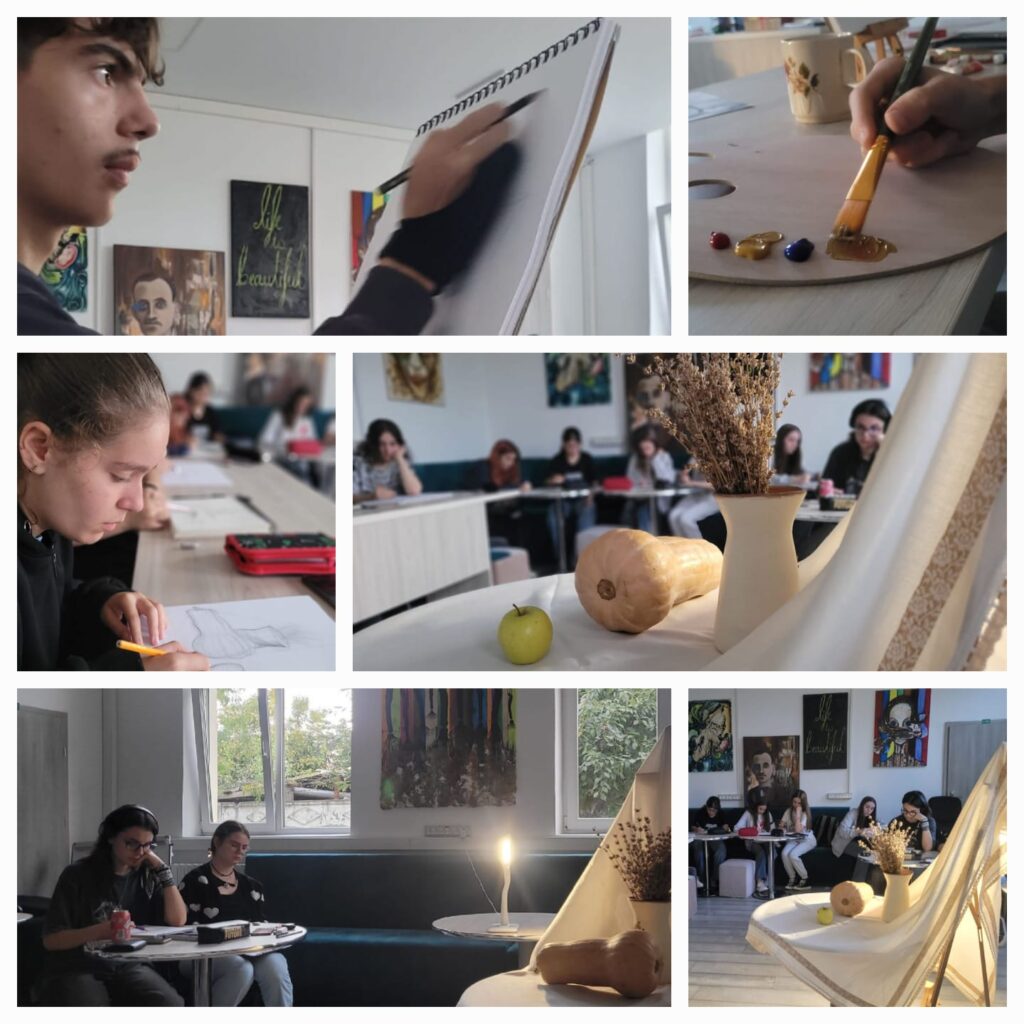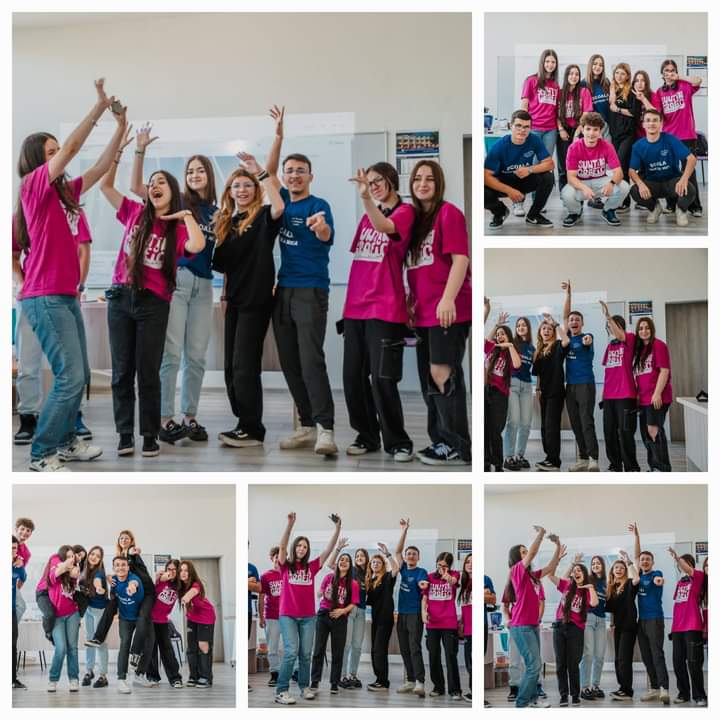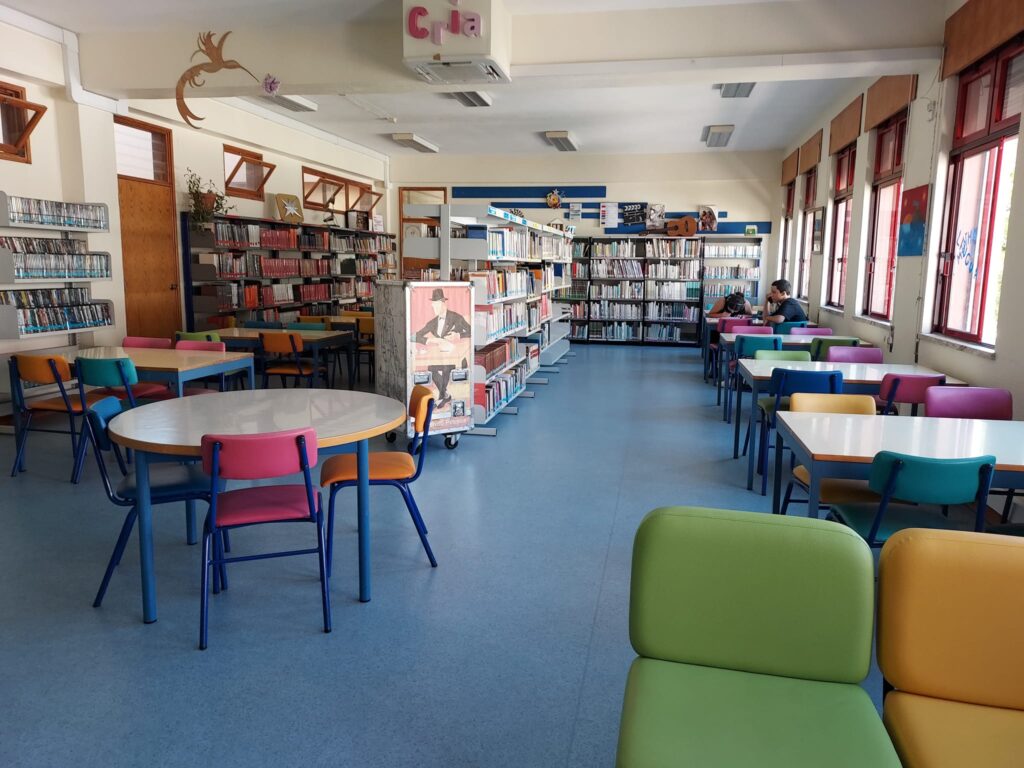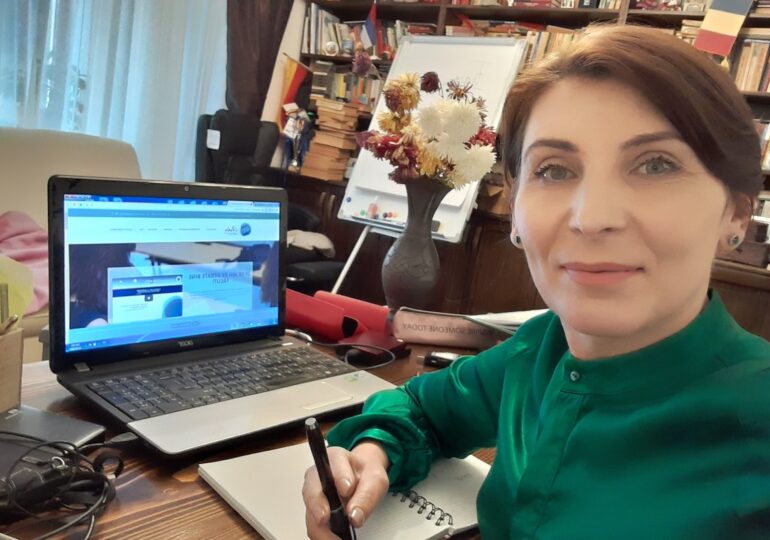We no longer understand their ‘software.’ They move very quickly, consume information rapidly, and we end up working on completely different software at times, which probably leads to incompatibility, their boredom, and our dissatisfaction,” says Prof. Elena Manea, the director of the Theoretical High School „Ioan Cotovu” in Hârșova.
Prof. Manea took over the school’s leadership during the pandemic and managed to turn it into a truly student-centered school, starting from simple questions:
"We can easily categorize them: superficial, agitated, not doing anything. We should analyze their agitation: why are they agitated? Because what we offer them, school and family, no longer aligns with what they want, with their method, with their vision. We, the teachers, need to be in tune with the times."
The adaptation was not easy, certainly not without resistance and obstacles, it required a lot of work and wrinkles, new equipment, chasing funds, and, most importantly and most difficult, the battle with mentalities:
"I tell my colleagues at all our meetings to break out of the 'in my time' mold. I look back 10 years at the generation I was a form teacher for, and then at the generation I am teaching now, and I realize they are not the same."
And the school's purpose in Prof. Manea's vision is not the accumulation of content:
"If we still aim with this generation to transmit content, it's a wrong approach from the start. We should teach them life models, raise life issues for them to find answers to, which they can then apply."
Director Elena Manea spoke in an interview for spotmedia.ro about how a school for the digital generation should be conceived.
Could the main problem of the Romanian school be perhaps the fact that the student is generally kept at a distance, that learning is a burden, something hostile that they have to overcome? Can this be changed?
Sure, it can be changed, but we all need to understand, school - family - society, what and how exactly needs to be changed. We, teachers, cannot do everything; the family needs to support the school's efforts in this formative process.
Many times I think that we, teachers, are also guilty of a few things. We need to look carefully at the person in front of us so that we can observe the elements of personality around which to build our teaching approach.
Every year, when I take the 10th grade, I reread the fairy tale with different eyes, because I have a different 10th grade in front of me. And I try to adapt the content and teaching strategy to what I have identified in the class, to their needs, concerns, and areas of interest.
We may not always like what we observe, but it may be valid for an efficient teaching scenario, similar to a marketing-sales department scenario: those who have a product to sell, and we have education to sell, look at the client and offer a product to satisfy them.
Knowing the graduate profile, we build class hours by harnessing each student's potential. Certainly, this marketing lens should not be exaggerated, as we are a learning space, but we must always relate to the students.
But many teachers and parents have in mind the client they were each in a time that has nothing in common with our times. The pre-internet world.
I tell my colleagues at all our meetings to break out of the 'in my time' mold. Let it go! It doesn't work anymore; we need to shake ourselves and say: enough!
"Our time" was a period with many pros and cons, but you can't do the same thing in different circumstances. I look back 10 years at the generation I was a form teacher for, and then at the generation I am teaching now, and I realize they are not the same.
It is an effort to "update" ourselves to the new generations, which we need to consciously achieve, supported by specialized readings about current generations, professional development courses, sharing best practices.
I took on the role of director during the pandemic, a period that affected us, teachers, as well, not just the students. We sat in front of screens, posted some things, we weren't prepared. We should learn some lessons. We should take the positives and negatives of that experience and move forward.
How is today's "client"? More superficial, faster?
Last year, I told a 9th-grade girl that if I had written her essays when I was in the 9th grade, I would be a genius by now.
I had read an extraordinarily well-written essay, with a profound message relevant to our present. Some of today's students have a certain depth.
We can easily categorize them: superficial, agitated, not doing anything. We should analyze their agitation: why are they agitated? Because what we offer them, school and family, no longer aligns with what they want, with their method, with their vision. We, the teachers, need to be in tune with the times.
I believe that in 2024, a teacher cannot enter a class without taking courses, reading, without seeing a profile of today's adolescents. You cannot conduct good lessons without connecting with the students of these times.

It is clear that they are much quicker at making decisions, thinking, making connections. These are the happy children, who often have the support of their families.
There is also a category of unhappy children, often abandoned by their families, in various forms - physically and/or emotionally.
There is also the expert family, which knows everything, knows how to educate from Facebook, Instagram, TikTok. It often intervenes unhappily and after often having a painful experience, returns to school.
In defense of the "expert" parent, shouldn't it be said that there is a great lack of trust in what schools provide today? The parent often sees that between their child and school, there is a gap. Aren't children simply misunderstood?
Of course, it can be like that. It would be good for us as teachers to reflect in the evening or after class: did we do well, did we not, did we see everyone, did we involve them? Did we manage to convey something? Did we reach everyone?
In my classes, I often emphasize the ethical and moral message of literary works, the connection to students' real life, highlighting the literary character's experiences with the thought of instilling in them motivation, decision-making, success, and failure.
Yes, the lesson can be seen as a show, probably like in theater, every day you have to reinvent yourself, to receive applause at the end. Ours are the students who learn. It's like a successful business, knowing how to reinvent a product for the continuity of the process.

Let's see students as a laptop, which is version 2.1, 2.2, or as an application, with software 2.0. We should ask ourselves: If we, as teachers, are at version 1.0, how do we want to function with children who are at version 5.0?
Yes, we no longer understand their "software." They move very quickly, consume information rapidly, and we end up working on completely different software at times, which probably leads to incompatibility, their boredom, and our dissatisfaction.
Will you be asked: is today's mathematics different from that of my time? The third-degree equation, isn't it the same? Isn't Eminescu the same?
The content is the same. However, we do not teach content. When teaching about Eminescu, I no longer do it with the aim for the student to know the year of birth, the year of death, seven works, a commentary.
My vision is long-term. When the student leaves the classroom after I've read them a poem, what do they take with them into the break, home? What message do they take from the lesson for life?
I have transformed them, from the desk, into Harap Alb to experience all the adventures? And let's see what we all take from the analysis of the literary work, that is, of the life presented in the literary text?
If we still aim with this generation to transmit content, it's a wrong approach from the start. The content is in the library, in printed or digital form. Wouldn't it work better to reinvent, recalibrate the learning space as a positive, friendly space where they want to learn?
We should teach them life models, raise life issues for them to find answers to, which they can then apply. When students connect classroom content to real life, I am sure they will be more engaged in their own learning.
But doesn't this contradict what all national exams evaluate, namely exact memorization of content?
The issue of the differences between the academic path in school and what we evaluate at the end of the schooling cycle implies a system transformation. Those in the 11th grade should have different programs. We still don't have programs or plans for high school. It is not our decision, but it has consequences on our work.
After 4 years, maybe you, as a teacher, develop competencies and try to build the graduate a profile as close as possible to a future society, they sit at the exam and write a 400-word essay, templated. I think this somehow diminishes their motivation for learning.
And it's frustrating for teachers too. You want to engage in ingenious, creative teaching approaches, but you are forced, for pass rates, to follow well-trodden paths and sometimes offer prefabricated products because the Bacalaureat average counts for college, and the national evaluation average is the high school admission.
I don't think the ministry doesn't know what needs to be changed in the system. I think it's about embracing a paradigm shift, but I also believe that people within the system still hold onto the old teaching paradigm.
Isn't it also about the industry of tutoring for which this type of evaluation is essential?
I watched a math teacher on TV very disappointed with a 9th-grade class, where the last student had an admission average of 9.80. She expected them to be open-minded, to react very well to questions, challenges, to possess thinking, analysis, problem-solving skills.
Well, the teacher lady was saying that if she took them a bit out of their comfort zone, away from algorithms and deliverables, they would get stuck, unable to work logically.
I don't agree with tutoring. If the teacher does their job and the student is engaged, there shouldn't be a need for tutoring. Additional preparation hours may be necessary where the admission requirements exceed the high school curriculum or in medical situations.
Even today, we have many colleagues who provide extra tutoring with students weekly, free of charge, in the school space, for those lagging behind, for high-achieving students, preparation for national exams.
How many of your colleagues have shown openness to teaching differently?
Difficult! It's a component we are still struggling with. A flaw in the system comes from the training of the teaching staff: 85% of teachers have obtained the first teaching degree, they are tenured, and the challenge no longer exists.
I believe that you cannot be a teacher with a first teaching degree at the age of 30 because you lack the necessary experience, you don't have time to mature intellectually and professionally. I would also add the unhappy stories behind obtaining these teaching degrees - supporting classroom inspections, supporting methodical-scientific papers.
Older colleagues recount how you had to wait 7 years between degrees, during which you had to successfully complete further training courses, undergo multiple rigorous inspections and written exams, publish papers. Do we really see a transformation in a colleague from Degree II to Degree I? Only in some unfortunate cases, and those individuals would have evolved even without the degree.
So, I believe a reconfiguration of obtaining these teaching degrees is necessary, just as the psycho-pedagogical training of future teaching staff is essential.
Sometimes problems arise from the lack of standards. What does a grade of 5 in Romanian in the 10th grade in the first learning interval mean? A 7 means something to me and something else to my colleague. Hence, perhaps the lack of trust in the system you mentioned. Evaluation should be based on clear, easily applicable standards that we all use and that students and parents are aware of.
But, in parallel, we also have innovative colleagues. We are pleased to have a MERITO teacher in our school - Mrs. Professor Țepeș Daniela, who recently shares with us the latest in pedagogy and supports colleagues in reconfiguring the didactic approach towards efficiency.
She proposed learning through experiments/questions to colleagues, and I proposed the method of academic debates, while colleagues who have completed courses disseminate the possibilities of integrating technology. I believe we are a learning school community.
Another aspect that greatly burdens the school is bureaucracy. For some time now, we have been doing what the social assistance should be doing, preparing documentation for various social programs.
This time is taken away from lesson preparation, a situation that generates frustration, as teachers are required to fulfill tasks that go beyond our scope of preparation.
Do you lack teachers?
For the past 2-3 years, we have been facing a shortage of physics, chemistry teachers in the entire area, and it is starting to be felt in mathematics as well. This year we had major concerns in biology; we had to split the position among three people brought in from other schools.
A long-term strategy is needed so that we do not end up resorting to unqualified individuals. We also need to pay attention to the level of preparation they bring from university - both in terms of scientific knowledge and especially in terms of classroom management, modern teaching strategies.
The university training of students aspiring to become teachers must consider the future generations of children. They need constant activity, to always feel involved, challenges, activities that require critical thinking, communication, teamwork, (self)learning strategies.
What role should equipment play for this generation of digital natives?
The phone has become an extension, so the teacher in class should know how to seamlessly integrate them into learning. We have applied for all announced fundings, entered the implementation phase of these projects, and are starting to enjoy the school spaces, the acquired technology. We started with a PNRAS project for school dropout prevention, managed to set up the library, equipped two "smart classes," and carried out many activities with students, among which the most successful were the PNRAS Summer School editions.
We brought technology into the classroom, knowing that those who will know how to use it will be mostly the students. We realized that our generation approaches technology with fear, afraid of damaging it. Students do not have this fear. Our task was to integrate technology into learning.
We conducted several training sessions, but I believe there is room for improvement. I also told colleagues that we need to learn when we feel overwhelmed. There is no shame in finding an assistant in the room. In each class, I found a student to help me, especially with those who are quiet in Romanian. They feel extremely valued to help me with technology, and I feel saved.
We have interactive whiteboards in all classrooms, internet connection in all school spaces. Sometimes colleagues are still afraid to use a device for fear of embarrassing themselves in front of the students.
The other day, I invited an IT businessman from the area to come and teach us how to make the most of what we have in the classrooms to deliver impactful lessons.
We started from an example found on the internet; there is the story of a third-grade child when the teacher, from my generation, tries for 20 minutes to teach the water cycle just by using spoken words. Seeing that it's not working, the teacher finds a 3-minute video explaining it, and the child happily says: yes, now I understand.
I believe that for these generations, words are no longer enough. For this generation of students, the recipients are different, and technology could help us reach them.
Yet, you almost performed a miracle. Making children reach out for printed books. How did you do it?
First of all, I believe we should not exaggerate and say that these young people no longer read. There are many students who have a slightly different reading preference compared to what we had at their age; there are students who read a specific type of literature a lot, and yes, we acknowledge there are students who do not read at all.
Becoming a principal, one of the first things I set out to correct in the school was the library, a dusty place where children only saw some large rows of outdated shelves with books, which were often never moved from there. They were not even allowed to touch them, to get to know them.
In homeroom, with the previous generation, I talked to the students about reading and asked them very honestly why they don't read or why they don't enter a library. And what they told me helped me build a vision of how the library should look for them, and I started looking for funding.
It wasn't easy, it's still not easy today, but I believe that reading will save us. I also studied the issue from various angles: how it should look, changed the furniture, made it multifunctional and group-oriented, added a TV, a projection space, a sofa, some bean bags.
We relocated the library to make it bigger, created a HUBLife so that it could be a space where students can be anytime, not just during activities, not just sent by someone. It should be their space. Everything is new, comfortable, beautiful, and useful.

Subsequently, I scheduled homeroom classes there so that students would enter the library with joy, not be scared anymore, and the word "library" would no longer sound like a punishment. It's not a punishment to read. Some optional courses are held there, as well as extracurricular activities.
Then, the library extended to the school hallways. Children see the books, can browse them anytime, can take books. On each floor, we have at least two shelves where we took out books, and when children meet during break, they arrange them, flip through them, discover them, and some ask for them to read. They started coming to the library, taking a book and sitting there, borrowing books.
There is also a space with computers and printers, where they can work in groups on projects and homework. In school, there are students who commute and have come to ask if they can stay in the library, which is beautiful.
There is work behind these achievements, but seeing them go there during breaks, seeing them sit at a table with a book, discussing about themes and characters is a huge gain forever.
We took the strategy further, on the second component: the teachers' and librarian's activity to keep them in the library and close to books. From now on, we will open the books even more, show them that in their pages are stories taken from the lives of those who lived, and bring them closer to reading, studying, intellectual work.
The interview transcript was created with the Vatis Tech application.

